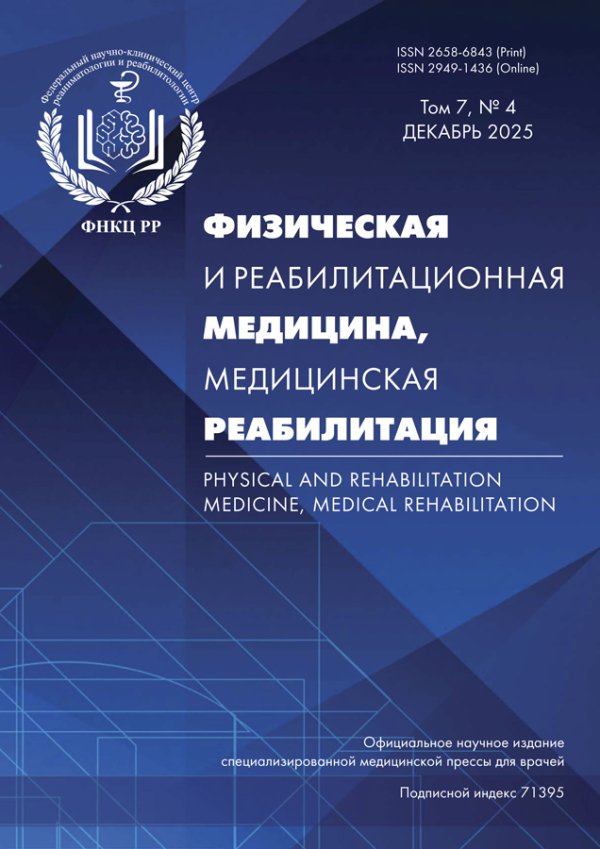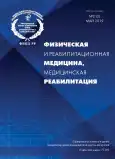TENDENCIES IN DEVELOPMENT OF MEDICAL REHABILITATION, FROM PAST TO FUTURE
- Authors: Treger I.1,2, Lutsky L.L3
-
Affiliations:
- Soroka University
- Ben-Gurion University of the Negev
- Clalit Health Services
- Issue: Vol 1, No 2 (2019)
- Pages: 101-106
- Section: Articles
- URL: https://journal-vniispk.ru/2658-6843/article/view/19194
- DOI: https://doi.org/10.36425/2658-6843-19194
- ID: 19194
Cite item
Full Text
Abstract
Full Text
##article.viewOnOriginalSite##About the authors
Iuly Treger
Soroka University; Ben-Gurion University of the Negev
Email: iulyt@clalit.org.il
Soroka University Medical Center, Rehabilitation Department; Ben-Gurion University of the Negev, Medicine Beer Sheva, Israel
Lena L Lutsky
Clalit Health Services
Email: treiuly@yandex.ru
South Department, Rehabilitation Unit Beer Sheva, Israel
References
- Definition of medical rehabilitation services. American Journal of Physical Medicine: October 1975 - Volume 54 - Issue 5 - ppg 269
- Gutenbrunner C, Meyer T, Melvin J, Stucki G. Towards a conceptual description of physical and rehabilitation medicine. J Rehabil Med 2011; 43: 760-764
- Conti AA. Reconstructing medical history: historiographical features, approaches and challenges. Clinica Terapeutica, 2011, vol. 162, no.2, pp.133-136
- Atanelov L, Stiens SA, Young MA. History of physical medicine and rehabilitation and its ethical dimensions. American Medical Association Journal of Ethics, June 2015, V 17, N 6: 568-574
- Opitz JL, Folz TJ, Gelfman R, Peters DJ. The history of physical medicine and rehabilitation as recorded inthediary of Dr. Frank Krusen: part 1. Gathering momentum (the years before 1942). Archives of Physical Medicine and Rehabilitation, 1997, vol.78,no.4,pp.442-445
- House of Commons Debate, 17 October 1940, vol.365, cc867
- Blum N, Fee E. The Polio Epidemic in Israel in the 1950s, American Journal of Public Health, February 2007, Vol. 97, No. 2, 218
- Paran G, Rozenberg-Friedman L, Ohry A. The development of the rehabilitation medicine concept in Israel (1948-1974), Harefuah. 2015 Jul;154(7):451-5, 451- 455
- International classification of impairments, disabilities, and handicaps: a manual of classification relating to the consequences of disease, published in accordance with resolution WHA29.35 of the Twenty-ninth World Health Assembly, May 1976. Available from: WHOhttp://apps.who.int/iris/bitstream/10665/41003/1/9241541261_ eng.pdf
- International Classification of Functioning, Disability and Health: ICF. World Health organization. World Health organization: Geneva; 2001. Available from: http://www.who.int/classifications/icf/icf_more/en/
- Stucki G, Bickenbach J, Gutenbrunner C, Melvin J. Rehabilitation: The health strategy of the 21st century. J Rehabil Med. 2017 Jan 31. 49, 111
- Ring H, Feder M, Schwartz J, Samuels G. Functional measures of first-stroke rehabilitation inpatients: usefulness of the Functional Independence Measure total score with a clinical rationale. Arch Phys Med Rehabil. 1997 Jun;78(6):630-5
- Ring H, Itzkovich M, Dynia A. Survey on the use of function assessment and outcome measures in rehabilitation facilities in Israel (SUFA 2004). Isr Med Assoc J. 2007 Feb;9(2):102-6.
- Ptyushkin P, Cieza A, Stucki G. Most common problems across health conditions as described by the International Classification of Functioning, Disability, and Health. Int J Rehabil Res. 2015 Sep;38(3):253-62
- Salter K, Jutai J, Hartley M, Foley N, Bhogal S, Bayona N, Teasell R. Impact of early vs delayed admission to rehabilitation on functional outcomes in persons with stroke. J Rehabil Med 2006; 38: 113-117
- Bernhardt J, Dewey H, Thrift A, Collier J, Donnan G. A Very Early Rehabilitation Trial for Stroke (AVERT) Phase II Safety and Feasibility. Stroke, 2008;39:390-396
- Yamakawa K, Inoue S, Nishida O, Kondo Y, Fuke R, Hifumi T, Hatakeya-ma J, Tetsuhiro T. Early rehabilitation for the prevention of postintensive care syndrome in critically ill patients: a study protocol for a systematic review and meta-analysis, BMJ open 2017, 7, 1-7
- Luft AR, Kesselring J. Critique of A Very Early Rehabilitation Trial (AVERT). Stroke, 2016;47:291-292
- Gagnon D, Nadeau S, Tam V. Ideal timing to transfer from an acute care hospital to an interdisciplinary inpatient rehabilitation program following a stroke: an exploratory study. BMC Health Services Re-search20066:151
- Dreeben O. Development of the physical therapy profession. Introduction to Physical Therapy for Physical Therapist Assistants. Sudbury, MA: Jones and Bartlett; 2007:3-22
- Zwecker M, Wolff J, Shaoul T, Zeilig G, Treger I. People with Spinal Cord Injury in Israel, American Journal of Physical Medicine & Rehabilitation, 2017 Feb; 96 (2): 78-79
- White book on physical and rehabilitation medicine in Europe. Avial-able from: http://www.euro-prm.org/docs/white_book_v_5_2.pdf
- Belda-Lois JM, Mena-del Horno S, Bermejo-Bosch I, Moreno JC, Pons JL, Farina D, Iosa M, Molinari M, Tamburella F, Ramos A, Caria A, Solis-Escalante T, Brunner C, Rea M. Rehabilitation of gait after stroke: a review towards a top-down approach, Journal of NeuroEngineering and Rehabilitation 2011, 8:66
- Morone J, Paolucci S, Cherubini A, Angelis DD, Venturiero Y, Coiro P, Iosa M. Robot-assisted gait training for stroke, Neuropsychiatric Disease and Treatment 2017:13 1303-1311
- Laver K, George S, Thomas S, Deutsch JE, Crotty M. Virtual reality for stroke rehabilitation: an abridged version of a Cochrane review. Eur J Phys Rehabil Med. 2015 Aug;51(4):497-506
- Kahn LE, Lum PS, Rymer WZ, Reinkensmeyer DJ. Robot-assisted movement training for the stroke-impaired arm: does it matter what the robot does? J Rehabil Res Dev. 2006;43(5):619-630
- Treger I, Faran S, Ring H. Robot-Assisted Therapy for Neuromuscular Training of Sub-Acute Stroke, Patients. A feasibility study, European Journal of Physical and Rehabilitation Medicine, Dec;44(4):431-5, 2008
- Treger I, Ring H, Schwartz R, Tsabari R, Bornstein NM, Tanne D. Hospital disposition after stroke in a national survey of acute cerebrovascular diseases in Israel. Arch Phys Med Rehabil 2008, 89(3):435-440
- Greenberg E, Treger I, Ring H. Post-stroke follow-up in a rehabilitation center outpatient clinic. Isr Med Assoc J 2004;6:603-6
- Anderson C, Rubenach S, Mhurchu CN, Clark M, Spencer C, Winsor A. Home or Hospital for Stroke Rehabilitation? Results of a Randomized Controlled Trial. Stroke. 2000;31:1024-1031
- Outpatients Service Trialists. Therapy-based rehabilitation services for stroke patients at home. Cochrane Database Syst Rev. 2003;1 :CD002925
- Wottrich WA, von Koch L, Tham K. The meaning of rehabilitation in the home environment after acute stroke from the perspective of a multiprofessional team. Phys Ther. 2007;87:778- 788
- Fisher RJ, Walker MF, Golton I, Jenkinson D. The implementation of evidence-based rehabilitation services for stroke survivors living in the community: the results of a Delphi consensus process. Clinical Rehabilitation 2013, 27(8) 741-749
- Worobey L, Rigot S, Hogaboom N, Venus C, Boninger ML. Investigating the Efficacy of Web-based Transfer Training on Independent Wheelchair Transfers through Randomized Control Trials. Arch Phys Med Rehabil. 2017 Aug 3. pii: S0003-9993(17)30495-1
- Ritvo P, Obadia M, Santa Mina D, Alibhai S, Sabiston C, Oh P, Campbell K, McCready D, Auger L, Jones JM. Smartphone-Enabled Health Coaching Intervention (iMOVE) to Promote Long-Term Maintenance of Physical Activity in Breast Cancer Survivors: Protocol for a Feasibility Pilot Randomized Controlled Trial. JMIR Res Protoc. 2017 Aug 24;6(8):e165
- Treger I, Landesman C, Tabacaru E, Kalichman L. Influence of home-based exercises on walking ability and function of post-stroke patients. International Journal of Therapy and Rehabilitation 2014; 21(9):441-446
- Jagroop D, Maebrae-Waller A, Dogra S. The feasibility of an exercise program for individuals 12 months post-stroke in a small urban community. J Sports Med Phys Fitness. 2017 May 9. doi: 10.23736/S0022-4707.17.07414-X
Supplementary files







